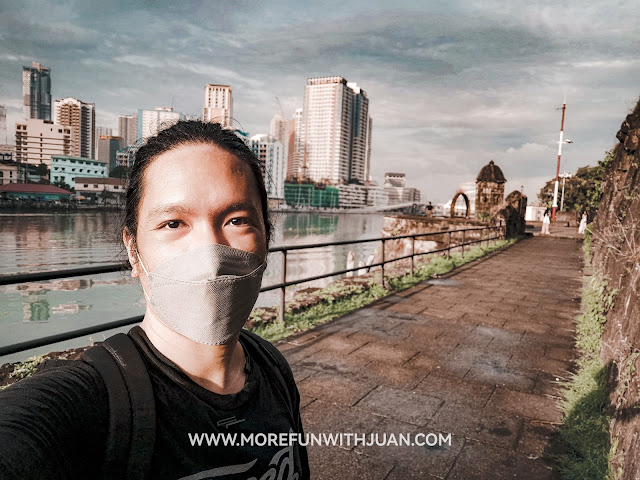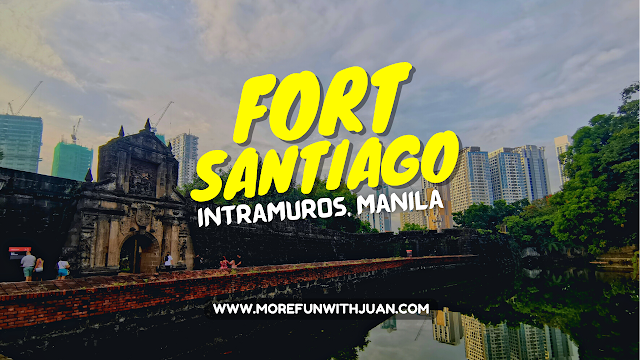Learn more about this old fortification in Manila!
UNDERSTANDING FORT SANTIAGO
Fort Santiago is one of the oldest fortifications in Manila built by the Spaniards in 1571 from what was once a palisaded structure of logs and earth built by Rajah Soliman on the native settlement called Maynila. The colonizers recognized that the tongue of land where the Pasig River flowed into the Manila Bay was a very strategic location.
The fort was destroyed in 1574 during the Chinese attack led by Limahong. The stone fort was built between 1589 and 1592 and was repaired and extended after being damaged by the 1645 earthquake. Spanish, British, American and Japanese occupation forces used the fort as their headquarters and a prison for men, women, children and soldiers.
The fort is one of the most important historical sites in Manila. Several people died in its prisons during the Spanish Empire and World War II. José Rizal, one of the Philippine national heroes, was imprisoned here before his execution in 1896.
 |
| American occupied Fort Santiago in 1940 |
After its destruction during the Battle of Manila in 1945, the fort was used by the U.S. Transportation Corps as a depot until it was turned over to the Philippine government in 1946. In 1950, Fort Santiago was declared a Shrine of dom and restoration began the following year.
Fort Santiago Today
After its destruction during WWII, Fort Santiago was declared as a Shrine of Freedom in 1950. Its restoration by the Philippine government did not begin till 1953 under the hands of the National Parks Development Committee.
The Intramuros Administration now manages the reconstruction, maintenance, and management of the fort since 1992.
Today, the fort, its bastions, and the prison dungeons for criminals used by the Spanish officials, is now part of a historical park which also includes Plaza Moriones and several ruins.
The park houses well-preserved legacies from the Spanish Colonial Period including memorabilia of José Rizal at the Rizal Shrine, a replica of his ancestral house in Laguna province.
Watch my recent walk tour in Fort Santiago here:
Adaptive use of this famous historical landmark makes certain areas ideal for open air theater, picnics, and as a promenade. The Intramuros Visitors center gives an overview of the various attractions in the walled city.
Loading...
Fort Santiago in Details
Here are important facts and information you should know about Fort Santiago:
- Type: Bastioned fort
- Architectural style: Italian-Spanish school of fortification
- Location: along Pasig River
- Town or city: Intramuros, Manila
- Coordinates: 14°35′42″N 120°58′10″E
- Named for: Saint James the Great
- Construction started: 1590
- Completed: 1593
- Renovated: 1733
- Dimensions: 2,030 feet (620 m) perimeter
- Structural system: Masonry
- Architect(s): Gómez Pérez Dasmariñas (1590), Fernándo Valdés y Tamon (1730s)
- Designations: National Historical Landmark
- Website: visitfortsantiago.com
Fort Santiago Day Tour
Though considered as a tiny piece of the northwest side of Intramuros as a whole, Fort Santiago itself is a huge place to tour around. To make the most out of your visit, it is highly suggested for you to take a personal tour guide. However, if you are like me who wants to wander alone and explore to learn, then you may go ahead and read the rest of this guide for your DIY tour to Fort Santiago.
Here's a map guide and key places to not miss during your Fort Santiago tour:
1. Ticket Booth
To start your tour, you have to pay for PHP 75.00 entrance fee (PHP50.00 for visitors under 18, senior citizens, students and PWDs). Last entry is 7:00PM during weekdays and 8:00PM on weekends.
2. Intramuros Visitors Center
3. Security Booth
Here's Fort Santiago's security booth.
 |
| Fort Santiago's security booth |
4. Almacenes Reales
Across the plaza are the remains of the Almacenes Reales or Royal Warehouses, first built in the 16th century.
 |
| Almacenes Reales |
It was a storehouse for goods unloaded by ships at the river gate, as well as a warehouse for supplies of the fort and other government offices. The wall behind the building was leveled by American military engineers in the 1900s for easy access to the river wharves.
5. Plaza Moriones
Named after Spanish Governor-General Domingo Moriones, this plaza was used as a public promenade until the 1863 earthquake destroyed Fort Santiago.
6. Baluartillo de San Francisco Javier
Built in 1662, this was part of the seafront defense of Intramuros. The original fortification was extended as a curtain wall after a section was destroyed together with the governor-general’s residence during the 1645 earthquake.
 |
| Baluartillo de San Francisco Javier |
Named after St. Francis Xavier, patron saint of foreign missions and one of the founders of the Society of Jesus or the Jesuit Order, the baluartillo was used as storage chambers until the early 20th century.
7. Reducto de San Francisco Javier
This structure was built in 1773 under the supervision of Engineer Dionisio O’Kelly. The baluartillo defended the curtain wall from possible seaside attacks and also doubled as a storage area for ammunition and food supplies.
8. Ruins of the American Barracks
Alongside the solid curtain wall of Baluartillo de San Francisco Javier are the ruins of a building which as the American Barracks. Former Philippine President Elpidio Quirino was imprisoned in this building for 16 days in 1943, during the Japanese Occupation.
9. Wall of Martyrs
This brass plaque contains the list of survivors and roll of honor of Filipinos incarcerated and tortured inside Fort Santiago during World War II. Water cure treatment was a common torture method used during the war.
10. Rajah Soliman Mural
Sulayman, sometimes referred to as Sulayman III, was a Crown Prince of the Kingdom of Luzon in the 16th century and was a nephew of King Ache of Luzon.
 |
| Rajah Soliman Mural |
He was the commander of Luzonian forces in the battle of Manila of 1570 against Spanish forces. His palace was within the walled and fortified city of Manila.
11. Bamboo Garden
Bamboo Garden is the former site of the Bastión Hererias Maestranza. It is named after two adjacent structures: the royal foundry (Hererias) and the royal armory (Maestranza) located beside Plaza Militar.
 |
| Bamboo Garden in Fort Santiago, Intramuros |
Built sometime during the 17th Century, cannons and armaments were manufactured and stored here. In 1824, the bronze statue of Carlos IV (now located in Plaza Roma) was molded and cast in this foundry.
The maestranza was closed down during the 19th Century and the building was used as an office by the American Military for the Manila Arsenal. It was destroyed during World War II.
12. Moat
The Moat in Fort Santiago was restored in the 1980s together with the main gate. This man-made canal joined the Pasig River and Manila Bay, making Fort Santiago a veritable island.
13. Fort Santiago Gate
Here stands the gate leading to the inner sanctum of Fort Santiago. The gate of Fort Santiago was destroyed during the Battle of Manila in 1945.
The main gate is decorated by a relieve or wood relief carving of Santiago Matamoros (St. James, the “Moor-slayer”), the patron saint of Spain; together with the coat of arms of the Kingdom of Castile and Leon. What remains of the original gate are the embossed Spanish soldiers, now defaced.
The image of St. James (Santiago), a symbol of Spanish sovereignty, decorates countries occupied by the Spaniards, such as Chile and Mexico.
14. Baluarte de San Miguel
Named after St. Michael the Archangel, this rampart was built in 1609 to fortify the seaside defenses of Fort Santiago.
15. Medio Baluarte de San Francisco
16. Plaza de Armas
At the center of Fort Santiago is the Plaza de Armas. The plaza and its name is a common feature in fortresses built by the Spaniards in their colonies throughout the world.
 |
| Plaza de Armas |
It got its name from the use of the area to stock arms and rifles when not in use. This is also where the soldiers marched around in their daily drills.
17. Ruins of a Spanish colonial era barracks
18. Museo ni Rizal
Administered by the National Historical Commission of the Philippines (NHCP), this shrine reaffirms Rizal’s significance in Philippine history – how his death served as the inspiration in the struggle for Philippine independence.
 |
| Museo ni Rizal |
This brick barracks, which was first built in the 16th century, has been in a ruined state since its destruction during the Battle of Manila in 1945. Here Jose Rizal was imprisoned for 56 days, from November 3 to December 29, 1896. The entire right wing of this building which contained his prison cell was reconstructed in 1953 as a museum and as a shrine dedicated to Jose Rizal. It was renovated in 1998 for the Philippine Independence Centennial, and subsequently modernized in 2014.
19. Rajah Soliman Theater
This was formerly the Infantry Quarters of Fort Santiago, but destroyed during the Battle of Manila in 1945. It was renovated in 1967 by National Artist for Architecture, Leandro Locsin and turned into an open-air theater for the use of the Philippine Educational Theater Association or PETA.
 |
| Rajah Soliman Theater |
PETA staged most of their plays here until they moved to a new theater in Quezon City in 2005. New backstage facilities were added during recent improvements to the Rajah Soliman Theater.
Chapel Cell at the Rajah Soliman Theater
This main room of the soldiers’ school was converted into a chapel-cell for Dr. Jose Rizal, who was transferred here after 56 days of imprisonment at the soldiers’ barracks across Plaza de Armas. It was here in the morning of December 30, 1896 that Rizal married Josephine Bracken, an Irish woman who lived with Rizal during his four-year exile in Dapitan, Zamboanga del Norte, a province in southern Philippines.
ATTRACTIONS TO SEE IN MANILA
Klook.com20-21. Postigo de la Nuestra Señora de Soledad and promenade
This postern was used by the occupants of Fort Santiago as a passage to the Pasig River. During the British invasion of Manila in 1762, Simon de Anda escaped to the province of Pampanga through this postern.
 |
| Postigo and Paseo Nuestra Señora de la Soledad |
Manila was eventually returned to the Spanish in 1764. The riverside promenade outside was rehabilitated by the Tourism Infrastructure and Enterprise Zone Authority or TIEZA as an additional attraction.
22. Casa del Castellano
We are now standing on the site of the residence of the commander of the fort called Casa del Castellano, or House of the Castilian, referring to the Fort Commander.
 |
| Casa del Castellano |
The structure was built in the 17th century and subsequently expanded until its destruction in World War II.
23. Dungeons
The dungeons below were originally used as powder magazines until the dampness proved detrimental to storing gunpowder. These were then converted into prison cells.
 |
| Entering the dungeons of Fort Santiago |
The dungeons were recently rehabilitated and are now open to the public. Stories of prisoners being drowned in the dungeons of Fort Santiago during high tide continue to this day, but archaeological evidence proves the dungeons were built way above the river level and it would be impossible for waters to flood the chambers even at high tide.
 |
| Reopened dungeon in 2020 |
Also located nearby was a water cistern which supplied fresh water to the fort from a well in the dungeons below. The cistern was converted into a storage room when the US Army built their headquarters here.
24. White Cross
After the Battle of Manila in 1945, 600 decomposing bodies were found around Intramuros. Their remains lie in a mass grave under a white marble cross beside the Dungeons.
25. Mi Ultimo Adios Gallery
 |
| Mi Ultimo Adios Gallery |
26. Baluarte de Santa Barbara
This structure was named in honor of St. Barbara, the patron saint of armorers, artillerymen, miners and others who work with explosives. According to legend, St. Barbara’s father died when he was struck by lightning after beheading Barbara himself. As such, Spaniards and Filipinos call the saint for protection after lightning or thunder, by uttering “Sta. Barbara,” while making the sign of the cross.
 |
| Baluarte de Santa Barbara |
This was built in the 16th century to protect the entrance from the Pasig River. It is the highest defensive structure in Fort Santiago. Vaults, a powder magazine, and the soldiers’ quarters above were added later. It was renovated and reconstructed in the 18th century. The new headquarters and administrative offices of the U.S. Army were built on top of the baluarte in the 1900’s. The Americans also added a tower and a driveway for vehicles connected to what is today Bonifacio Drive.
27. iMake History Fortress LEGO Education Center
The chambers of the Baluarte de Santa Barbara presently house the iMake History Fortress LEGO Education Center.
 |
| iMake History Fortress LEGO Education Center |
Visitors could look at LEGO models of lost landmarks in Intramuros as well as miniatures of other places of interest in the Philippines.
28. Falsabraga Media Naranja
Falsabraga means “false wall”, owing to the fact that it is lower than the main wall. This is an added protective layer of stone wall that reinforces the Baluarte de Santa Barbara from heavy bombardment. It is shaped like half of an orange, thus, the name “media naranja”.
29. Falsabraga de Santa Barbara
ACTIVITIES AND TOURS IN MANILA
Fort Santiago
Visiting Hours:
- Mon to Fri: 9:00AM to 8:00PM (Last entry – 7:00PM)
- Sat to Sun: 6:00AM to 9:00PM (Last entry – 8:00PM)
Entrance Fee:
- PHP 75.00 regular
- PHP 50.00*
*Discounted rate to apply if visitor is a child (<18), senior citizen (≥60), student (currently enrolled), person with disability (PWD), or a government employee (Government of the Philippines). Please present a valid ID.
 |
| Me at the end of my Fort Santiago tour in 2022 |
Places to Not Miss in Intramuros
Here are the tourist spots and IG-worthy places you should visit in Intramuros:
- Fort Santiago and its dungeons
- The 8 Gates (Puertas) of Intramuros
- Minor Basilica of the Immaculate Conception, the Manila Cathedral
- La Cathedral, European-Vibe Rooftop Dining with a Romantic View in Intramuros
Or you can visit 20+ Most Famous Tourist Spots in Manila
For hassle-free and more educational tour, I suggest that you get a DOT Accredited tour guide for your visit to Intramuros. Or you can visit my complete DIY guide to the walled city.
Where to Stay in Intramuros
Here's a list of hotels and accommodation inside and nearby Intramuros:
- Octagon Mansion Hotel - Check Rates and Availability!
- Bayview Park Hotel - Check Rates and Availability!
- Go Hotels Ermita - Check Rates and Availability!
- City Garden Suites Hotel - Check Rates and Availability!
- Pearl Manila Hotel - Check Rates and Availability!
- Sunny Bay Suites - Check Rates and Availability!
MANILA TOUR
Some other attractions to see and things to do near Intramuros:
- Visit Arroceros Forest Park
- Food crawl in Binondo
- Visit the Dolomite Beach in Manila Bay
- Have fun at Star City
- Have a relaxing staycation at SMDC Breeze Residences
- Go shopping in Divisoria
ALSO IN MANILA
- MANILA TRAVEL GUIDE: Tourist Spots, Things To Do, Where To Eat and Where to Stay
- REDISCOVER MANILA: 20+ Tourist Spots To Visit At Night (Things To Do & New Places To Go)
- BINONDO FOOD CRAWL: DIY Food Trip Guide to Manila Chinatown, the oldest in the world (Map & Budget)
- RIZAL PARK: Guide to Luneta, the Largest Urban Park in Manila, Philippines (Attractions to See & Things to Do)
- MANILA OCEAN PARK: Attractions Map Guide, Activities & How to get Discounted Pass Online Tickets
- DOLOMITE BEACH: Everything you need to know about this new attraction at Manila Baywalk (Operating Hours, Directions & FAQs)
- INTRAMUROS GUIDE: Historic Walled City in Manila (What to See & to Do)
- ARROCEROS FOREST PARK: Guide to the Last Lung of Manila (Description, History and Schedule)
- The historical Jones Bridge in Manila got a new look
- LRT-1 Guide (Stations, Schedule, Fare Matrix)
- WHERE TO EAT SAMGYUPSAL: 10 Korean BBQ Restaurants in Metro Manila (YOU MUST TRY)
- INSTAGRAMMABLE CAFES: 10 Unique Places to Have Coffee in Manila
- Manila City Zip Codes & Phone Area Codes (Complete List)
- List of Palawan Pawnshop Branches (Pera Padala) in Manila
- List of Mercury Drug Branches in Manila City (with Store Hours & Contact Details)
- List of Watsons Branches in Manila City (with Store Hours & Contact Details)
 IMPORTANT NOTE: The rates, contact details and other information indicated in this post are accurate from the time of writing but may change without IMFWJ's notice. Should you know the updated information, please let us know by leaving a message in the comment box below.
IMPORTANT NOTE: The rates, contact details and other information indicated in this post are accurate from the time of writing but may change without IMFWJ's notice. Should you know the updated information, please let us know by leaving a message in the comment box below.WHERE TO STAY IN MANILA
Fort Santiago map Image of Fort Santiago inside Fort Santiago inside Feedback fort santiago history fort santiago entrance fee who built fort santiago fort santiago dungeon fort santiago tour fort santiago opening hours
























No comments
Let us know your thoughts!